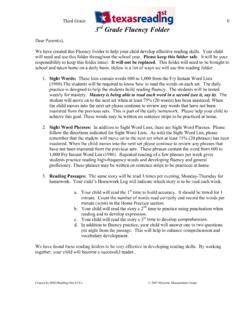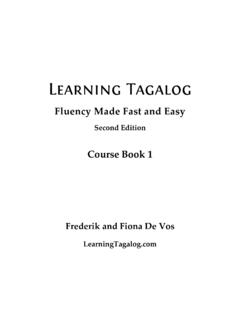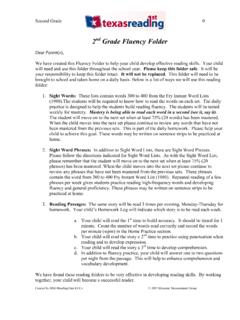Transcription of Assessment of Fluency Disorders and Intervention
1 Katherine Lamb, , CCC/SLPGSHA2019 Assessment of Fluency Disorders and InterventionGSHA_2019_Lamb1 Financial and non-financial disclosurestatement Relevant Financial Relationship(s):I am a salaried employee of Valdosta State University; University System of Georgia. Relevant Nonfinancial Relationship(s):I have no relevant non-financial relationship(s) to disclose related to this presentation at is stuttering? Disruption in the forward flow of speech Complex interactions in the individual s environment Individual s abilities Elements in stuttering include cognition & linguistic formulation Not just speech motor Cause is not known Do know that it involves linguistic planning This planning must be faster than motor execution, so conclude use of higher level functionsGSHA_2019_Lamb3 What are our assumptions in assessing an individual with stuttering?
2 A child suspected of having a problem with Fluency also has other SLVH or B Subtle to significant We choose the assessments based on our experience, knowledge, beliefs, and assumptions of a disorder Have awareness, extensive knowledge and understand current research & dataGSHA_2019_Lamb4 Comprehensive Assessment H & B Client, significant others, parents, and/or teachers descriptions Developmental information Academic areas if appropriate Standardized/formal assessments, including: Speech & language Articulation Phonology Vocabulary: receptive and expressive Morphological & syntax MLU Any stressors that influenceGSHA_2019_Lamb5 Assessment goals Differentiate those who stutter and those who do not Compile the results for the layperson Have rationale for the Intervention plan Remember those other factors Motor speech & language skills, support from others, emotional influences, motivation.
3 And cognition Include the individual s perspective for prioritizing therapyGSHA_2019_Lamb6 Assessment Developmental history Disfluencies Secondary behaviors Beliefs and emotions Other speech and language skills Other individuals and parent s beliefsGSHA_2019_Lamb7 Assessing disfluencies Syllable & word count of stuttering frequency Collect language samples from conversation & oral reading Calculate frequency and duration of disfluencies Typical disfluencies: hesitations, filler words, revisions, phrase & word repetitionsGSHA_2019_Lamb8 Assessing Disfluencies Atypical disfluencies include blocks, prolongations, sound syllable and word repetitions Disruption in forward flow Struggle behavior(s)
4 Reduced or no eye contact Avoidance behaviors Questionnaires for situations and emotionalGSHA_2019_Lamb9 Assessing Behaviors Stuttering is highly variable across environments Important to get a representative picture across all environments Word and situation avoidances can be difficult to identify This makes identifying avoidances even more difficult May have other S&L or clutteringGSHA_2019_Lamb10 Interviewing Interviews with the client, parents, other family members can assist & provide valuable insights into understanding Ask broad & open-ended questions Descriptions, occurrences, times lines, situations, episodesGSHA_2019_Lamb11 Specific areas to address in the assessmentRate of productionsContinuity of the productionsRhythm EffortNeed to also determine the presence, or rule out the presence & severity Core behaviorsSecondary behaviorsNegative attitudes & feelingsGSHA_2019_Lamb12 Assessing core, secondary and attitudes Core behaviors Continuity, rate, & rhythm of speech Types & frequency, rate & prosodic features Secondary behaviors Physical efforts of speech Observe & record escape behaviors Questionnaires can help determine avoidance behaviors Attitudes, emotions & feelings Assessment of the mental effort of speech Questionnaires on self-worth.
5 Self-perception, life-goalsGSHA_2019_Lamb13 Classification (Guitar 2006) Borderline Beginning Intermediate AdvancedGSHA_2019_Lamb14 Beginning Between 2-8 years Muscle tension Rapid, irregular repetitions & prolongations Pitch rise Escape behaviors develop FrustrationGSHA_2019_Lamb15 Advanced Between 13 & adulthood Very similar to intermediate may even display fewer core behaviors because they have developed so many avoidance behaviors Well-developed self-image as a stuttererGSHA_2019_Lamb16 Differential Diagnosis Normal developmental disfluency & early signs of stuttering are often difficult to differentiate diagnosis made tentatively both direct observation & information from the client s speech in differentsituations & different timesGSHA_2019_Lamb17 Different Types.
6 Episodic stress reaction Not clinically significant for SLP normal disfluencies but without avoidanceGSHA_2019_Lamb18 Different Types: Psychogenic stuttering Traumatic experience Grief Breakup of a relationship Psychological reaction to physical trauma Homogeneous Sudden onset & associated with a significant event Not influenced by speaking situations Little awareness or concern GSHA_2019_Lamb19 GSHA_2019_Lamb20 Developmental stuttering Young children Most common form of stuttering Some scientists believe that DS occurs when children s S&L abilities are unable to meet verbal demands DS runs in families NIDCD researchers isolated three genes that cause stuttering (NIDCD 2010)Different Types.
7 Neurogenic stuttering After a CVA, TBI, or other brain injury Brain has difficulty coordinating the different components because of signaling problems between the brain & nerves or musclesGSHA_2019_Lamb21 Cluttering Fluency disorder characterized by rapid and/or irregular speaking rate excessive disfluencies language or phonological errors & attention deficits A Fluency disorder, not stuttering & excessive disfluencies: Does not sound fluent Excessive levels of normal disfluencies Little or no apparent physical struggle in speaking Few if any secondary behaviors A rapid and/or irregular speaking rate: Talks too fast Sounds jerky. Pauses that are too short, too long, or improperly placedGSHA_2019_Lamb22 How to decipher: Stuttering or not Part word repetitions Single syllable repetitions Dysrhythmic phonations Adams (1977) Interjections Polysyllabic word repetitions Phrase repetitions RevisionsThree SLDsODsComparison of DisfluenciesSpeech Characteristics More Typical of the Normally Disfluent Child Speech Characteristics More Typical of the Beginning Stutterer1.
8 9 or fewer disfluencies per 100 words (includes all types)1. at least 10 disfluencies per 100 words (includes all types)2. whole-word and phrase repetitions, interjections and revisions are the predominant types2. part-word repetitions, audible and silent prolongations and broken words are the predominant types3. 2 or fewer unit repetitions per part-word repetition ("b-b-ball")3. at least 3 unit repetitions per part-word repetition ("b-b-b-ball")4. schwa vowel ("uh") not present, ("bee-bee-beet" not "buh-buh-beet")4. schwa vowel ("uh") present, ("buh-buh-beet" not "bee-bee-beet")5. little if any difficulty starting and/or sustaining voicing or air flow for speech; interruptions are generally brief and effortless5.
9 Frequent difficulty in starting and/or sustaining air flow or voicing for speech; interruptions are generally more forced and of longer durationGSHA_2019_Lamb23 Yairiand Ambrose (1992) Include those more typical of stuttered speech, SLD part-word repetitions single-syllable word repetitions dysrhythmic phonation These are examples of these disfluencies & how they may be coded If there is more than one disfluency on a word (a disfluency cluster), each disfluency should be coded. "d-d-d-----dog dog is big," = part-word repetition, prolongation, and single-syllable word repetition = ([PW3] [DP] [WW1] DOG IS BIG)GSHA_2019_Lamb24 Examples: Yairiand Ambrose (1992)UtteranceDisfluency Coding1.
10 S-s-s-seethe duckPart-word repetition[PW3] See I-I-Iwant to go thereSingle syllableword repetition[WW2]I want to go Whe----re is it?Disrhythmic phonation[DP]Where is it?4. I um go [I] (UM) I want the word repetitionI want the [M] I go---Igo to the repetition[P] (I go) I go to the I ride my my [R] (bike) I want to go want to go>GSHA_2019_Lamb25 Stuttering Severity Instrument(SSI-3 & SSI-4) Severity: SSI: based on frequency of disfluencies, duration of blocks, and physical concomitants very mild, mild, moderate, severe, very severeGSHA_2019_Lamb26 GSHA_2019_Lamb27 Assessment of Fluency in School-Age Children Criterion referenced instrument for children 5-18 years Multi-sourced and multi-factored format Differential evaluation Parent/teacher interviews SL & Physiological functionGSHA_2019_Lamb28 Assessment of Stuttering Behaviors Parental Diagnostic Questionnaire Classroom Fluency ChecklistSummary of what to do with a Fluency Assessment Case History Careful observation of speech behavior Collect speech samples Measure frequency and type of stuttering Collect information about attitudes toward speaking Plan treatment PrognosisGSHA_2019_Lamb29 Intervention for StutteringKatherine





